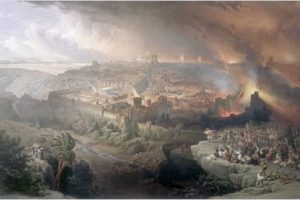In the 1930s, the teaching of the Church of God (Seventh Day), herein COG7, whose name changed from Church of God (Adventist) in 1922, was that the Crucifixion of Jesus of Nazareth occurred on a Wednesday. This appears to have been the understanding of the denomination when it was known as the Church of God (Adventist). The literature of the period did not commit COG7 to a specific year for the Crucifixion, although the year 31 AD appears to have been a common belief. The 31 AD date came into COG (Adventist) from the teachings of the Ellen Gould (Harmon) White (1827-1915) and the Advent movement of the 1840s. White told of a vision she received which sealed 31 AD as the year of the Crucifixion for Adventists.
In the late 1920s, Herbert W. Armstrong and his wife Loma appear to have come to the 31 AD Crucifixion understanding while living in Oregon from people affiliated with the COG (Seventh Day). Armstrong and his wife further concluded on the basis of their independent Bible study that God intended for His people to keep the biblical holydays and associated festivals, which separated them from COG7, as well as the Biblical Sabbath Day. The latter observed from sunset Friday evening to sunset Saturday evening. The Armstrong’s had to determine on which dates in the modern Gregorian calendar the biblical holydays and festivals fell. Today, the Rosetta CalendarSM facilitates easy and accurate date conversion.
Armstrong relied on the rabbinic dating of Passover (Nisan 14), but balked at the rabbis placing Shavuoth (Pentecost) on the fixed date of Silvan 6. The rabbinate of our present-day world, the spiritual descendants of the Pharisees not the Aaronic priests, wrongly place Shavuoth 50 days from the fixed date of the annual Sabbath of Nisan 21 (the final day of the festival of unleavened bread). The biblical method, practiced by the Aaronic priesthood, was by counting inclusively, that is beginning with the weekly Sabbath falling during the days of unleavened bread. For many years, Armstrong assumed counting the days to Pentecost was counting exclusively as is the practice of English speakers, but later learned that the biblical counting to Pentecost (Shavuoth) was inclusive and embraced that practice.
COG7 and the breakaway Seventh Day Church of God determined the Passover date based on the vernal equinox not the Hebrew Perpetual Calendar. The premise assumed by Armstrong was that the Hillel II calculated calendar (the Hebrew Perpetual Calendar) generally provided the correct dates for the biblical holydays and festivals with exceptions such as the Christian Passover (known commonly as the Lord’s Supper) and Pentecost. For the Crucifixion to fall on a Wednesday in 31 AD there had to have been a high priest-declared postponement as the Perpetual Hebrew Calendar places Nisan 14 on Monday, March 26 in 31 AD. But with the one month postponement, Nisan 14 fell on Wednesday, April 25, 31 AD which is the correct date of the Crucifixion of Jesus of Nazareth (that is Jesus Christ, our LORD and Savior).
In 1934, by the Hebrew Perpetual Calendar, Nisan 14 began at sunset/dusk on Thursday night, March 29, extending through sunset/dusk Friday, March 30. The Bulletin of the Churches of God in Oregon for April 1934 records the following:
The most solemn and sacred event of the year was observed in taking the Lord’s Supper on Thursday night, March 29th, calculated as the 14th Nisan, Hebrew calendar. (April 1934)
The Bulletin of the Churches of God in Oregon (April 1934)
This confirms that in 1934, Armstrong and his followers, the Churches of God in Oregon, observed the Lord’s Supper (the Christian Passover) according to the Hebrew Perpetual Calendar and explains how they came to the understanding that the Crucifixion fell, not on a Friday, but on Wednesday, April 25, 31 AD and the Resurrection late Saturday, April 28, 31 AD.
See Dating the Crucifixion Part 1 and Part 2.


Recent Comments